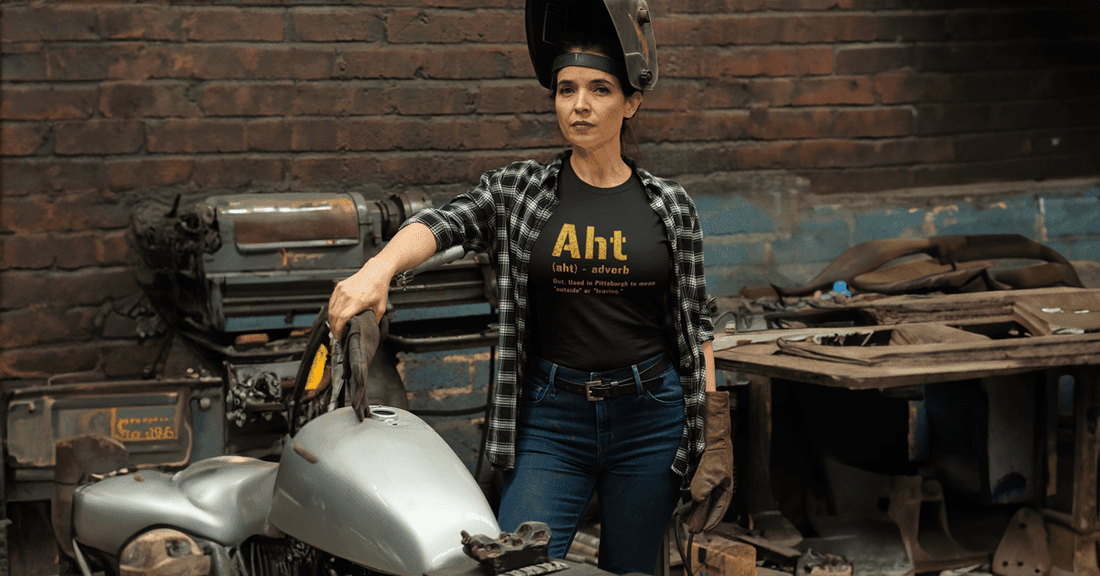
Pittsburghese for Beginners: A Yinzer’s Guide to Talkin’ the Talk
Share
Pittsburghese: The Only Guide Yinz’ll Ever Need (n’at)

Welcome to the land of jumbo, gumbands, and “yinz.” Whether you grew up crushin’ chipped ham sammiches in the South Hills or you’re just a fan of the Black and Gold from across the country, Pittsburghese is more than just a dialect it is a flag we wear proudly.
In this guide, we’ll break down everything you need to know about the Steel City’s beloved lingo: from its immigrant roots and phonetic quirks to the everyday phrases that keep our culture alive. And yeah we’ll show yinz where to grab some of the best Pittsburghese gear while we’re at it.
What Even Is Pittsburghese?
Pittsburghese is a regional dialect native to Western Pennsylvania especially Allegheny County marked by unique vocabulary, grammar, and pronunciation. It’s a full-on language system with centuries of immigrant influence baked in like pierogies at a church festival.
The term "Yinzer" comes from the legendary second-person plural "yinz," which traces back to "you ones" (from the Scots-Irish). Over time, it morphed into the iconic regional identity we love today.
How Did We Start Tawk’n Like This?
The roots of Pittsburghese run deep — forged in steel mills, shaped by geography, and colored by the voices of immigrants from Ireland, Germany, Poland, Italy, and Appalachia.
- Scots-Irish: Gave us words like "redd up" (to clean up)
- German: Helped shape our flat “a”s and vowel shifts
- Eastern European: Brought in babushkas, haluski, and vowel simplification
Sound It Out: What Makes the Pittsburgh Accent So Unique
- Cot-Caught Merger: \"Cot,\" \"caught,\" and \"coat\" might all sound the same
- Monophthongization: \"Downtown\" becomes \"dahntahn\"
- GOAT/GOOSE Fronting: \"Pool,\" \"pull,\" and \"pole\" all blend
- Epenthetic R’s: Adding R’s to words like \"worsh\" (for \"wash\")
Talk Like a True Yinzer: The Vocabulary You Need to Know
- Yinz – You all
- Nebby – Nosy
- Slippy – Slippery
- Gumband – Rubber band
- Jagoff – Idiot or jerk (can be a term of endearment as well)
- Redd up – Clean up
- Jumbo – Bologna
- Dippy Eggs – Sunny-side up
- Kennywood’s Open – Your fly is down
- Buggy – Shopping cart
👉 Wanna show off your fluency? Grab our Pittsburghese Definition Mugs and Tees to help you speak the lingo with pride.
The Geography of Talkin' 'Burgh
West of the Alleghenies, Pittsburgh developed in a bubble. The hills and rivers helped create strong, isolated communities — and a distinct way of talking. While the accent doesn’t vary too wildly by neighborhood, some differences do sneak in between places like Greenfield and Greentree.
How Pittsburghese Took Over the World
You can take the Yinzer outta the ‘Burgh, but you can’t take the ‘Burgh outta the Yinzer. Whether you're tailgating in Tampa or grilling kielbasa in California, you'll find Pittsburghese echoing across the country. Even linguists say we’ve left a mark coast to coast.

From the Steel Era to Stillers Nation
Pittsburghese solidified during the city’s industrial boom — a mashup of immigrant languages, working-class pride, and neighborhood solidarity. Even after the steel mills closed, the dialect remained a cultural anchor passed from generation to generation.
Keepin’ It Alive (And On a T-Shirt)
The dialect lives on in:
- Street signs and road names
- Myron Cope quotes
- T-shirts, mugs, and hats from Yinzergear
- Local comedy, radio, and commercials
- The Kennywood parking lot
Final Tawk: Why It Matters
Pittsburghese reflects our grit, our humor, and our loyalty — from “slippy roads” to “dippy eggs.” It’s how we identify ourselves, find each other in faraway places, and celebrate where we’re from.
Before Yinz Go...
- ✅ Pick up some Pittsburghese gear
- ✅ Leave a comment tellin’ us your favorite Yinzerism
- ✅ Share this post with anyone who says “you guys” unironically
